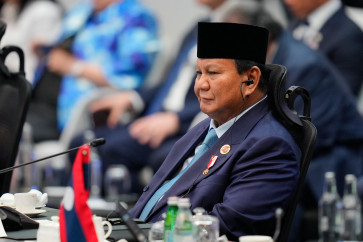Popular Reads
Top Results
Can't find what you're looking for?
View all search resultsPopular Reads
Top Results
Can't find what you're looking for?
View all search resultsONO GAF: Malang’s man of steel
Not all foreign words that migrate into Indonesian stay intact
Change text size
Gift Premium Articles
to Anyone
N
ot all foreign words that migrate into Indonesian stay intact. Sosialisasi now means community education, while “unfollow” demonstrates logic, if not authenticity.
Now consider artis, a word that has morphed into anybody with celebrity status, whether their talent is barren or fertile.
This story is about a real artist and will hopefully restore some luster to the term. The title has credibility beyond a journalist’s observation; for Malang sculptor and painter Sumarsono will get official recognition for a lifetime in the creative arts in April.
His award, from Malang Mayor Peni Suparto, follows a nomination from the Malang Arts Council. Peer recognition is a rare accolade, particularly in a profession awash with risks, loneliness, jealousy and self doubts.
If Sumarsono, 64, better known as Ono Gaf, ever fought these demons during his long career, they don’t show. His wife Tristianingsih Kenevel reckons he is not radically different from when they first met 40 years ago. A little less electric perhaps, for age drains the watts — but still vibrant.
A photo taken at an early exhibition shows a hippie in a black cloak painted as a skeleton. Now he favors Elton John glasses, beads, a badged cap like a much-traveled Rotarian, sarongs and sleeveless shirts.
When courting, he revealed to his potential bride that he was forever bound to a fickle and demanding mistress he’d met while still in primary school. He encountered her while lurking around Malang’s tramways and backstreet foundries, seduced by the sounds and smells of metal being reworked.
The transformation, the energy let free, the potential to create anew! Where others just saw old iron, Ono imagined fresh shapes and ideas ready to be born. He became the midwife.
Getting married to a man trying to express himself through an affair with steel would test anyone’s mettle. The family fortunes would fluctuate, for there would be no divorce from his first love, even though she might drive the couple and their three children into penury.
If success is measured by a black Mercedes in the driveway of a cool hill-town villa then Ono is still on the steaming floodplains riding his pushbike. If ranked by the number of his works in collections around the world and the teenage pleasure he still gets from art, then the man should be named to Forbes’ rich list.
Ono’s latest works, exhibited with 11 other invited sculptors from across the nation at the International Cultural Center in nearby Batu, include Pembunuh Osama (the killer of Osama bin Laden), a bizarre mix of metals creating a sci-fi monster of an American soldier, and Miss Indonesia.
This work will never arouse the interests of an antipornography task force. It features a round-faced Medusa with a tangled torso representing the strength of Indonesian women. It is an object of power, not beauty and lust.
Ono’s father was a tailor, his mother sold noodles and his eight siblings had interests other than art. Mom was also an embroiderer and recognized her son had design abilities worth encouraging, including great skills with the pencil and a natural feel for perspective.
Not so Dad. A religious orthodox, he forbade drawing or making anything that might be considered the likeness of a living creature. Although Ono broke the prohibition long ago, he still paints abstracts.
“We lived in a kampong alongside a mosque,” Ono recalled.
“Everyone was Muslim. It was a sterile and restrictive environment. I built a tiny studio in the attic and kept out of the way.
“When I wasn’t there, I was round the tram yards watching men work iron. I knew most Indonesian artists like to use wood, but timber rots and breaks. Iron and steel lasts. Then and now I’ve been the only one working like this.
“I learned how to forge and weld. I could communicate with metal. However, people laughed at my iron work — they didn’t think it was art.”
One who disagreed was a Dutch doctor who saw the creativity others missed. He paid 10 times the prices asked by Ono to encourage the young man to enlarge his mind.
This meant being exposed to European classical music and pictures. Fortunately, Malang, an academic city, is rich with secondhand bookshops. Other times he listened to Radio Australia on short-wave.
“I couldn’t afford to travel, but I could see the world through books,” he said. “I knew I had to learn. Books can’t make you rich but they can make you clever. Artists need to be intellectuals. Only then can art be great.”
Then Ono discovered a useful fact of Indonesian life. Contacts count. The doctor worked for the police, then run by the army. Regimented officers who wanted to tip-toe on the wild side without risking reputation were drawn to the unkempt but affable artist, willing to fulfill their fantasies in steel and concrete.
These commissions usually involved Soviet-style statues of bayonet-thrusting, grenade throwing heroes. They weren’t Ono’s idea of art, but they paid for him to build the weird iron figures he loved to create.
Through exhibitions (he’s had 11) he met foreign collectors who, he reluctantly admitted, appreciated his work more than locals.
The couple lives in a tiny kampong, this time behind a Protestant church. The area’s so cramped people duck when neighbors open shutters. No signs, so only dedicated art-enthusiasts know his whereabouts.
Every flat space of his 6-square-meter front room carries towers of photos, catalogues, clippings, knick-knacks and books, including five volumes of Michelangelo’s works.
“I believe in art and I believe in myself,” he said when pushed. “The life of an artist is up and down. I’ve never sought profit. Sometimes I give works away because I know I get blessings in return.
“Looking back I feel satisfied with what I’ve done, but I’m still learning. As an artist I should be honest and holy, not arrogant. To be creative is to be spiritual, to work hard and concentrate on God.”










